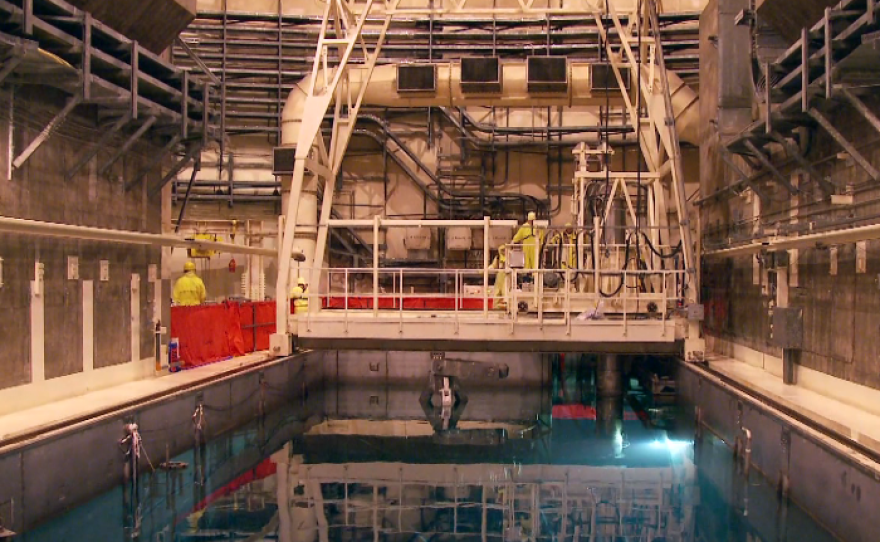San Onofre's nuclear reactors were permanently shut down earlier this year. Fully dismantling the plant will take years, probably even decades. But one of the problems facing San Onofre is going to stick around even longer. What to do with all its nuclear waste?
At a meeting hosted by the Nuclear Regulatory Commission, San Diegans will have their chance to discuss the reality of the nuclear waste that will stay on site for decades—and possibly centuries.
However long the waste stays at San Onofre, there's won't be any debate about sending it elsewhere. Leaving it on site is the only option. Victor Dricks, spokesperson for the Nuclear Regulatory Commission, says that's for a very simple reason.
"There is no other place to ship it to at this point," Dricks explains. The United States currently doesn't have anywhere to permanently store commercial nuclear waste, which will remain dangerous for many, many thousands of years.
We came close to putting a national repository in Nevada, deep underground beneath Yucca Mountain. But in 2010, the Obama administration canceled those plans.
Alpine resident Rosemarie Alley is the co-author of a book on nuclear waste called Too Hot to Touch. And she sees a huge irony in how plants around the country are handling nuclear waste.
"There's no way you can guarantee safety for any repository site — Yucca Mountain or anyplace else on the planet," she says. "So the fallback has become, well it's too dangerous to put it underground, so let's leave it lying above ground all over the country."
Without a national repository, it's up to the Nuclear Regulatory Commission to gauge the safety of leaving waste at sites like San Onofre for extended periods. Dricks says the NRC has determined waste could stay here for quite awhile.
"We have concluded that even over the next 300 years, the fuel could be safely stored on site," he says. "And that's part of the rule we're putting out here for public comment."

At Monday's meeting, San Diegans will have that chance to comment.
Currently, most of San Onofre's spent fuel is held in cooling pools, huge warehouse-sized tanks measuring about four stories tall. Thousands of spent fuel rods are mechanically inserted into the pools, where they need to cool down for at least five years. Eventually, they'll need to be taken out and inserted into dry casks.
I wanted to know how long that process will take. So I asked Maureen Brown, who handles media relations for Southern California Edison, the utilities company operating San Onofre. She couldn't provide a firm timeline.
"I'm just so reluctant to project out any specific dates," she says. "The best I can say based on our current planning is we would hope to have decommissioning completed within 20 years."
Even dry casks — basically long tubes made of concrete and steel — aren't a true long-term solution, though. They're only designed to contain radioactive waste for about 50 years. The Nuclear Regulatory Commission says waste would have to be transferred into new casks after 100 years. But Brown says Edison isn't planning that far ahead.
"It's not a priority for us to contemplate many decades in the future," Brown says, explaining that decommissioning the plant has taken precedence for Southern California Edison.
Edison didn't expect to be left handling this waste for so long. The federal government was supposed to take responsibility for it back in 1998. Fifteen years later, they still haven't.
Which brings us back to Monday's meeting. With a long-term repository nowhere near completion, how do Southern Californians feel knowing nuclear waste could be sitting on earthquake-prone coastal bluffs, near major cities, for generations?
Rochelle Becker will be at the meeting to voice her own lack of confidence. She heads up the Alliance for Nuclear Responsibility. And she wonders who will be keeping an eye on all this waste long after San Onofre is decommissioned.
"I probably will not be alive then," she says. "It will be incumbent upon the public to continue to pressure the Department of Energy to make sure there's a permanent waste repository somewhere. And that our grandchildren and our great-grandchildren and our great-great-grandchildren aren't living with nuclear waste on the seismically active coast of this state."
Monday's meeting in Carlsbad is one of several the NRC is holding around the country. But whatever the public has to say, the nuclear waste at San Onofre won't be going anywhere soon.






